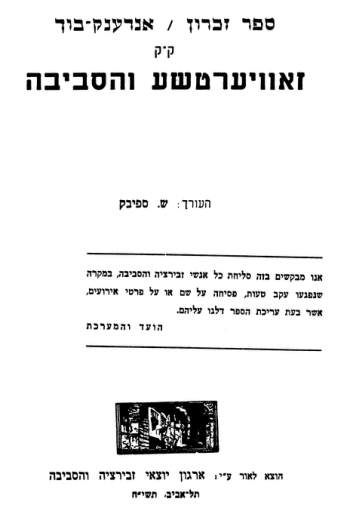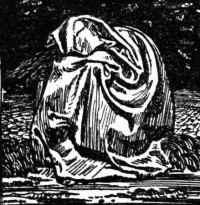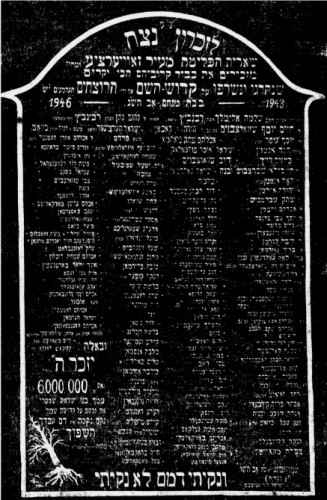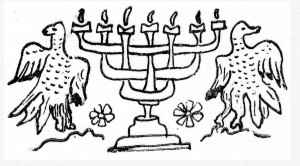 |
|
|
|
| {The yellow slip inserted in the title page reads as follows :}
We beg forgiveness from all the natives of Zawiercie and its environs whom we have embarrassed by any error, skipping of a name, or any other thing which we have overlooked when putting together this book The Committee and Editorial Board |
[Title page]
Editor: Sh. Spivak
(With the participation of the editorial board and the board of the organization)
Published by the Organization of Natives of Zawiercie and its Environs, Tel Aviv, 5618 (1958)
[Page 2]
With awe, we present our Yizkor book to the community. It is clear to us that a book is insufficient to express the depth of agony, pain, protest, and natural tendency toward revenge of a community, the vast majority of whose population and structure was annihilated during the 20th century in such a terribly cruel fashion. However, we, the people of Israel, are the People of the Book. It is therefore natural that our monument should first and foremost be a book. Until the great and awesome Day of Judgment, which will and must come, we will write of the atrocities [committed by the German Nazis] for our sake and for the sake of future generations.
In Israel we are connected to the book, but also to the sword. We, the People of Israel, have learned from the disasters suffered by our people. We will no longer stand defenseless before an enemy, as our tormented martyrs did during Hitler's era. Nevertheless, we cannot forgo the traditional weapon of our nation – the book – as an implement of protest and struggle against the annihilators of the People of Israel and the Israeli nation.
Therefore, let this book of ours serve as a monument over the mass grave of our holy nation – of a community of dear, peaceful, diligent, straightforward, G-d fearing and Torah observant Jews, over whose heads hovered the sharpened, cruel axe of the mass murderers – the likes of which have not been seen in all the history of the human race.
We spared no effort to ensure that this book would have great impact – both in terms of its external form and its content. We took care that the uniqueness of the character of Zawiercie would be given full expression, despite the modest means that we had at our disposal.
We hereby express the hope that our book will find approval as a serious historical work.
We thank all of those who assisted us in the publication of this book.
The Organization of Natives of Zawiercie and its Environs
The Organizing Committee
The editor and the editorial board
[Page 4]
{Page 4 is the Yiddish version of the Hebrew text on page 3}
[Page 5]
In this Yizkor book to the martyrs of Zawiercie we will be united with the memory of our dear ones -- our parents, brothers, sisters, relatives, friends and acquaintances, natives of Zawiercie and the surrounding area. They were tortured, abused, crushed, tossed about by the violent hand of the wild beasts, sent to the gas chambers and death camps to be snuffed out and annihilated.
We will never forget them. With sorrow and heartache let us recite Kaddish –

[Page 6]
The survivors of Zawiercie, who despite enduring torture and many difficulties, were saved from the destruction, gathered in the city of Straubing, and dedicated on 24 Av 5706 (summer of 1946) two memorial plaques in the Straubing synagogue in memory of the martyrs of Zawiercie. A photo of one of the two plaques is presented here.
[Page 7]

The list of the names on this plaque will be printed in another section of this book.
I am honored that, several months ago, our community charged me with the task of editing a book of memory and testimony for the holy community of Zawiercie and its environs – based both upon material that was collected over three years, and the material (which forms the majority) that I myself have collected over the past several months.
There are pluses, in that the editor of such a book is a native of the city, but there are also minuses. The pluses are that he knows the material thoroughly, has the ability to discern between important and unimportant material, possesses a love of the topic, etc. The possible minuses include excessive subjectivity, delving too far into issues that are trivial to the eyes of an outsider, and a biased opinion.
In this matter, I attempted to follow the middle course and preserve appropriate proportions to the extent that such is possible – with the exception of issues that are beyond the control of the editor. I have delved into the past to confirm any activity of a native of the city and any unique event mentioned. It is clear that many things, perhaps even very important things, were not included in the following surveys and memoirs. I beg the apology of the readers for any such unintentional omissions, which are due to the restricted time frame that was allotted to me.
With my meager resources, I have made efforts to ensure that the style of the content in both languages would be variegated and balanced for everybody. At first, it was our intention to provide brief summaries of each article in the other of the two languages that are used in this book. However, there was no time to do so. I would have been forced to significantly edit or rewrite the material from scratch (including the poems). I ask the forgiveness of the readers for this.
Names of towns and people are generally written in the style that was used by our martyrs of Zawiercie. The name of the city itself is written in Hebrew transliteration (except in the title page of the book – for technical reasons).
I attempted to avoid duplication of material in the book, although, that was not always possible. From the amount of material on an individual in this book, one should not make any assumptions regarding the importance of that person within the Zawiercie Jewish society. Some information on important personalities and events is written in an incidental way, as there was no one to review them appropriately. In the book, a great deal is written about the uniqueness of Zawiercie, our beloved and dear city, and we do not need to repeat this in the introduction.
[Page 10]
The book is dedicated to the martyrs of the Holocaust. It is therefore no wonder that a great deal of space is allotted in our book to that frightful era, and there is some repetition on occasion. However, any experience of a Zawiercie native from the blood drenched Nazi period is precious to us. Every word, every letter, is an outcry – a combined outcry of pain and anger. The heart is pained when reading any such line, and there is no room for the nitpicking of an editor.
I feel that I have not fulfilled my obligation if I failed to point out the many efforts of the members of the organizing committee: Yosef Finkel, Shimon Feigenblatt, Nachum Drezner, David Brott, Yoel Grinkraut, and the late secretary of the organization A. Zaks. They all worked and toiled so that the book will be released, despite the difficulties. I especially express my gratitude to Sh. Feigenblatt (the chairman of the organizing committee) and Nachum Drezner, who pushed aside their personal affairs and dedicated a great deal of time to the book.
I also note with gratitude the activities of the editorial committee (Moshe-Mietek Neiman of Ramat Hakovesh and Aharon Rosenzweig of Givat Hashlosha) – and especially the dedicated work of M. Neiman. Of course, thanks are due to all of those who graced the book with the fruits of their pen.
It is appropriate to specially note the following Holocaust and historical-literary research institutions: Yad Vashem, the Israeli Historical Institute of Jerusalem, the Rambam Library of Tel Aviv, the Shaarei Zion library of Tel Aviv, the University Library (the National Library) of Jerusalem, the Havodah Archives of Tel Aviv, and other research institutions that politely provided the necessary research material at my disposal. The directors of Yad Vashem and the Israeli Historical Institute gave me access to microfilms that had recently arrived from Poland and the United States. We were assisted by material that was sent to us by the Jewish Historical Institute of Warsaw, under the directorship of Professor B. Mark.
{The identical introduction appears in Yiddish on pages 10-12.}
by Sh. Spivak
Translated by Jerrold Landau
{Small map of Zawiercie region.}
Zawiercie lies at one of the lowest level of the plateau (above sea level[1]) that lies in the Jura Mountains from Krakow to Częstochowa.
The highest point in that plateau is located in Ogrodzieniec.
The fact that the region next to Zawiercie is lower than the further area has an influence on the climate, the soil quality, the water level, and the geological strata. All of this had an influence on the development of industry in Zawiercie.
At first there was no agricultural development in the district of Zawiercie, even though there was no shortage of water[2].
There were several reasons for that:
[Page 14]
the masses of melting snow from the mountains of the Krakow–Częstochowa highlands and especially from the high mountains around Ogrodzieniec streamed into the area. The sources of six rivers and streams lie in the Ogrodzieniec–Kromoów area: Pilica, Warta, Przemsza, White Przemsza, Liswarta, and Prosna. Abundant water is a benefit for industry, and especially for the textile industry.
The railway line, which was laid at the beginning in the 1840s for the transport of merchandise from Germany and Austria to Russia, served some 20–25 years later as a stimulus for the development of the coalmines, as well as for light and heavy industry.
|
|
However already in the earliest stages of its development the “higher” industrial powers impeded the development of the industry
[Page 15]
in the Zawiercie region. It is seemingly not well known that even during the pre–First World War Czarist era, the heavy industry in Zaglębie was in the hands of the German enterprises. Those same enterprises also had industry in the Ruhr and Saar districts of Germany, as well as some in Saxony. They manipulated the situation to ensure that the factories in the Ruhr area were better developed than the factories and the mines in the Zaglębie region.
Therefore, the industry in Zawiercie was stagnating in the period just before the First World War. The T.A.Z. [Stock Society of Zawiercie] – cotton mills that were operating in Zawiercie were developing somewhat, but it was also a German enterprise, and its development did not reach the level of industry in the Łodz or Tomaszów regions.
Hence, Zawiercie did not really develop since the Russian–Japanese War in 1904–1905. There was a constant stream of emigration from Zawiercie, balancing the immigration and natural growth. The population was stable, and counterbalanced, perhaps in the direction of modest growth, both with respect to the six or seven thousand Jews and with respect to the general population of 27–29 thousand at the beginning of the First World War in 1914.

Editor's Footnotes
|
|
JewishGen, Inc. makes no representations regarding the accuracy of
the translation. The reader may wish to refer to the original material
for verification.
JewishGen is not responsible for inaccuracies or omissions in the original work and cannot rewrite or edit the text to correct inaccuracies and/or omissions.
Our mission is to produce a translation of the original work and we cannot verify the accuracy of statements or alter facts cited.
 Zawiercie, Poland
Zawiercie, Poland
 Yizkor Book Project
Yizkor Book Project
 JewishGen Home Page
JewishGen Home Page
Copyright © 1999-2026 by JewishGen, Inc.
Updated 25 Feb 2014 by JH